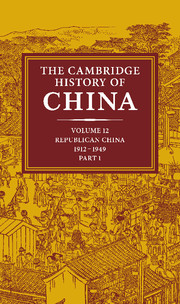Book contents
- Frontmatter
- 1 Introduction: Maritime and continental in China's history
- 2 Economic trends, 1912–49
- 3 The foreign presence in China
- 4 Politics in the aftermath of revolution: the era of Yuan Shih-k'ai, 1912–16
- 5 A constitutional republic: the Peking government, 1916–28
- 6 The warlord era: politics and militarism under the Peking government, 1916–28
- 7 Intellectual change: from the Reform movement to the May Fourth movement, 1895–1920
- 8 Themes in intellectual history: May Fourth and after
- 9 Literary trends I: the quest for modernity, 1895–1927
- 10 The Chinese Communist Movement to 1927
- 11 The Nationalist Revolution: from Canton to Nanking, 1923–28
- 12 The Chinese bourgeoisie, 1911–37
- Bibliographical essay
- Bibliography
- Index
- Republican China – physical features
- References
10 - The Chinese Communist Movement to 1927
Published online by Cambridge University Press: 28 March 2008
- Frontmatter
- 1 Introduction: Maritime and continental in China's history
- 2 Economic trends, 1912–49
- 3 The foreign presence in China
- 4 Politics in the aftermath of revolution: the era of Yuan Shih-k'ai, 1912–16
- 5 A constitutional republic: the Peking government, 1916–28
- 6 The warlord era: politics and militarism under the Peking government, 1916–28
- 7 Intellectual change: from the Reform movement to the May Fourth movement, 1895–1920
- 8 Themes in intellectual history: May Fourth and after
- 9 Literary trends I: the quest for modernity, 1895–1927
- 10 The Chinese Communist Movement to 1927
- 11 The Nationalist Revolution: from Canton to Nanking, 1923–28
- 12 The Chinese bourgeoisie, 1911–37
- Bibliographical essay
- Bibliography
- Index
- Republican China – physical features
- References
Summary
There is nothing intrinsically wrong in committing oneself to a political doctrine initially on emotional grounds. ‘How many Parisians had read Rousseau and how many St Petersburgers had read Marx before they plunged into their revolutionary movements? The point is that in their minds the ideas of Rousseau and Marx had already existed; Rousseau and Marx did no more than articulate these ideas.’ Revolution is a mass phenomenon which, however, achieves mass action only through the contemplation and planning of its leading elite. When the record comes under scholarly scrutiny, undue emphasis on the intellectual process of the leadership, which to some extent shapes the fast moving events, tends to downplay the role of mass emotions and mass demands. However inarticulate these emotions and demands may be, they are understood by the revolutionary leaders of the time, who are themselves guided by their own emotions and intellect, their own spontaneity and consciousness. Neither Lenin nor Trotsky was an exception to this. The interaction of emotion and intellect, instead of simplifying, makes the conversion to a political doctrine even more complicated. In the case of China between 1917 and 1921 the conversion to Marxism involved the perception of Chinese reality on the part of the converts, their personal temperament and traits, and their understanding of the doctrine itself.
CONVERSION TO THE DOCTRINE
The military weakness and economic misery of China had been clear to politically conscious Chinese long before the advent of Marxism; hence the call for national power and wealth. But it was not until the rise of reformist thought, including its more conservative t’i-jung school (see chapter 7), that the concept of 'a China worthy of devotion' began to emerge.
Keywords
- Type
- Chapter
- Information
- The Cambridge History of China , pp. 505 - 526Publisher: Cambridge University PressPrint publication year: 1983
References
- 2
- Cited by



